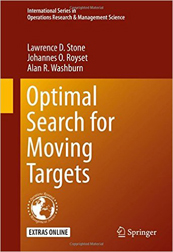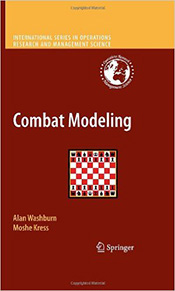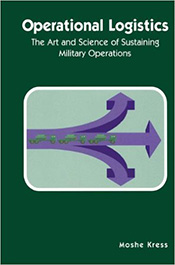OR Department Publications - Operations Research
OR Department Faculty Publications
Books & Chapters
Optimal Search for Moving Targets
L.D. Stone, J.O. Royset, and A.R. Washburn
 This book begins with a review of basic results in optimal search for a stationary target. It then develops the theory of optimal search for a moving target, providing algorithms for computing optimal plans and examples of their use. Next it develops methods for computing optimal search plans involving multiple targets and multiple searchers with realistic operational constraints on search movement. These results assume that the target does not react to the search. In the final chapter there is a brief overview of mostly military problems where the target tries to avoid being found as well as rescue or rendezvous problems where the target and the searcher cooperate.
This book begins with a review of basic results in optimal search for a stationary target. It then develops the theory of optimal search for a moving target, providing algorithms for computing optimal plans and examples of their use. Next it develops methods for computing optimal search plans involving multiple targets and multiple searchers with realistic operational constraints on search movement. These results assume that the target does not react to the search. In the final chapter there is a brief overview of mostly military problems where the target tries to avoid being found as well as rescue or rendezvous problems where the target and the searcher cooperate.
Warfare Modeling
Moshe Kress, Richard Rosenthal
 A compendium of warfare modeling by cross disciplinary experts. A must for any serious warfare or gaming modeler.
A compendium of warfare modeling by cross disciplinary experts. A must for any serious warfare or gaming modeler.
Combat Modeling
Alan Washburn, Moshe Kress
 Combat Modeling is a systematic learning resource and reference text for the quantitative analysis of combat. After a brief overview, authors Washburn and Kress present individual chapters on shooting without feedback; shooting with feedback; target defense; attrition models; game theory and wargames; search; unmanned aerial vehicles; and terror and insurgency. Three appendices provide a review of basic probability concepts, probability distributions, and Markov models; an introduction to optimization models; and a discussion of Monte-Carlo simulations. Drawing on their many years of experience at the Naval Postgraduate School in Monterey, California, Washburn and Kress have created a reference that will provide the tools and techniques for analysts involved in the underpinnings of combat decisions. This is a book that can be used as a military manual, reference book, and textbook for military courses on this vital subject.
Combat Modeling is a systematic learning resource and reference text for the quantitative analysis of combat. After a brief overview, authors Washburn and Kress present individual chapters on shooting without feedback; shooting with feedback; target defense; attrition models; game theory and wargames; search; unmanned aerial vehicles; and terror and insurgency. Three appendices provide a review of basic probability concepts, probability distributions, and Markov models; an introduction to optimization models; and a discussion of Monte-Carlo simulations. Drawing on their many years of experience at the Naval Postgraduate School in Monterey, California, Washburn and Kress have created a reference that will provide the tools and techniques for analysts involved in the underpinnings of combat decisions. This is a book that can be used as a military manual, reference book, and textbook for military courses on this vital subject.
Operational Logistics: The Art and Science of Sustaining Military Operations
Moshe Kress
 Operational Logistics: The Art and Science of Sustaining Military Operations explores military logistics in terms of the theoretical foundations of operational logistics (OpLog) and its applications. The theoretical foundations are examined with regard to two dimensions. First, the artistic or qualitative aspects of contemporary logistics are looked at in the context of the operational level of war. These OpLog aspects include principles, imperatives and tenets, which are stated and analyzed. The second dimension relates to the scientific aspects of logistics. It is manifested by a formal network model that represents the structural and operational features of an OpLog system. Hence the book examines both artistic and scientific dimensions of military logistics and integrates the respective qualitative and quantitative aspects into a unified and definitive presentation of operational logistics.
Operational Logistics: The Art and Science of Sustaining Military Operations explores military logistics in terms of the theoretical foundations of operational logistics (OpLog) and its applications. The theoretical foundations are examined with regard to two dimensions. First, the artistic or qualitative aspects of contemporary logistics are looked at in the context of the operational level of war. These OpLog aspects include principles, imperatives and tenets, which are stated and analyzed. The second dimension relates to the scientific aspects of logistics. It is manifested by a formal network model that represents the structural and operational features of an OpLog system. Hence the book examines both artistic and scientific dimensions of military logistics and integrates the respective qualitative and quantitative aspects into a unified and definitive presentation of operational logistics.
Fleet Tactics and Coastal Combat
Wayne Hughes
 This major revision updates Wayne Hughes's 1986 landmark study that is credited with providing decision makers a sound foundation for battle planning and tactical thinking. The book integrates the historical evolution of tactics, analysis, and fleet operations, and today it can serve as a primer for anyone who wants to learn how navies fight and win. This second edition includes much new material on combat in the missile age and reflects the reconfiguration of many tactics for littoral operations after the fall of the Soviet Union.
This major revision updates Wayne Hughes's 1986 landmark study that is credited with providing decision makers a sound foundation for battle planning and tactical thinking. The book integrates the historical evolution of tactics, analysis, and fleet operations, and today it can serve as a primer for anyone who wants to learn how navies fight and win. This second edition includes much new material on combat in the missile age and reflects the reconfiguration of many tactics for littoral operations after the fall of the Soviet Union.
Technical Reports
See all OR Department Technical Reports.
A scale-independent, noise-resistant dissimilarity for tree-based clustering of mixed data
by Samuel E. Buttrey and Lyn R. Whitaker
Clustering techniques divide observations into groups. Current techniques usually rely on measurements of dissimilarities between pairs of observations, between pairs of clusters, and between an observation and a cluster. In our scheme, we fit a set of regression or classification trees with each variable acting in turn as the “response" variable. Points are “close" to one another if they tend to appear in the same leaves of these trees.Trees with poor predictive power are discarded. We demonstrate the performance of this technique by using these dissimilarities to cluster some well-known data sets to which noise has been added.
Construction of cumulative mean bounds for simulation output
Dashi I. Singham, Michael P. Atkinson
We develop a new measure of reliability, called cumulative mean bounds, that assesses the mean behavior of a process by calculating the probability that the cumulative sample mean will stay below its long-term sample mean, with a given tolerance, over a period of time. In this report, we provide a derivation of a lower bound for the measure when the underlying data are independent and identically distributed with a normal distribution.This derivation provides a preliminary basis for parallel extensions to the two-sided limiting case when we calculate the probability that the sample mean stays within a given distance from the true mean when the assumptions of independence and normality are removed.
A comparison between the 3/9 and the 5/10 watchbills
Nita Lewis Shattuck, Panagiotis Matsangas, Stephanie Brown
This is the second phase of a longitudinal study comparing the fatigue levels, workload, and performance of crewmembers working on the 3-hrs on/9-hrs off (3/9) and the 5-hrs on/10-hrs off (5/10) watchstanding schedules. Crewmembers from the Reactor Department on the USS NIMITZ (N=117, 24.6±3.89 years old, 95 males, 109 enlisted, with 4.25±2.65 years of active duty) participated in this study. Results show that the 3/9 is better than the 5/10 in terms of sleep quality, subjective levels of fatigue, mood, psychomotor vigilance performance, and acceptance by the Sailors. Although crewmembers on both the 5/10 and the 3/9 received, on average, approximately seven hours of sleep per day, the sleep hygiene and acceptance of the two schedules differ considerably.
Cognitive Alignment with Performance Targeted Training Intervention Model: CAPTTIM
Quinn Kennedy, Peter Nesbitt, Jon Alt, Ronald D. Fricker, Jr.
In this technical report, we propose that the use of two simple behavioral measures, in conjunction with neurophysiological measures, can be used to create a training intervention that has the potential to provide: (1) real-time notification as to when a training intervention is needed and (2) real-time information as to the type of training intervention that should be employed. The Cognitive Alignment with Performance Targeted Training Intervention Model (CAPTTIM) determines if a trainee’s cognitive state is aligned or misaligned with actual performance. When misalignment occurs, it indicates that a training intervention is needed. Neurophysiological markers, as captured by eyetracking and electroencephalography (EEG), can assist in determining why misalignment between cognitive state and performance occurred, leading to more effective and targeted training intervention. Because all measures are captured continuously in real time, this model has the potential to increase training efficiency and effectiveness in a variety of training domains. The model is illustrated with two case studies.
Journal Articles
Operational Models of Infrastructure Resilience
David L. Alderson, Gerald G. Brown, and Matthew Carlyle
This paper received Society for Risk Analysis Award for Best Paper of 2015 in Risk Analysis.
We propose a definition of infrastructure resilience that is tied to the operation (or function) of an infrastructure as a system of interacting components and that can be objectively evaluated using quantitative models. Specifically, for any particular system, we use quantitative models of system operation to represent the decisions of an infrastructure operator who guides the behavior of the system as a whole, even in the presence of disruptions. Modeling infrastructure operation in this way makes it possible to systematically evaluate the consequences associated with the loss of infrastructure components, and leads to a precise notion of “operational resilience” that facilitates model verification, validation, and reproducible results. Using a simple example of a notional infrastructure, we demonstrate how to use these models for (1) assessing the operational resilience of an infrastructure system, (2) identifying critical vulnerabilities that threaten its continued function, and (3) advising policymakers on investments to improve resilience.
Optimality Functions and Lopsided Convergence
J.O. Royset and R. J-B Wets
Optimality functions pioneered by E. Polak characterize stationary points, quantify the degree with which a point fails to be stationary, and play central roles in algorithm development. For optimization problems requiring approximations, optimality functions can be used to ensure consistency in approximations, with the consequence that optimal and stationary points of the approximate problems indeed are approximately optimal and stationary for an original problem. In this paper, we review the framework and illustrate its application to nonlinear programming and other areas. Moreover, we introduce lopsided convergence of bifunctions on metric spaces and show that this notion of convergence is instrumental in establishing consistency of approximations. Lopsided convergence also leads to further characterizations of stationary points under perturbations and approximations.
Sleep duration increases in rough sea conditions
Panagiotis Matsangas, Nita L. Shattuck, and Michael E. McCauley
Environmental motion can affect shipboard sleep of crewmembers. Slamming and similar harsh motion may interfere with sleep, whereas mild motion and sopite syndrome may enhance sleep. If sleep needs vary by sea condition, this factor should be considered when assessing human performance at sea. The goal of this study was to assess sleep duration in different sea conditions.
treeClust: An R Package For Tree-Based Clustering Dissimilarities
Samuel E. Buttrey & Lyn R. Whitaker
This paper describes treeClust, an R package that produces dissimilarities useful for clustering. These dissimilarities arise from a set of classification or regression trees, one with each variable in the data acting in turn as a the response, and all others as predictors. This use of trees produces dissimilarities that are insensitive to scaling, benefit from automatic variable selection, and appear to perform well. The software allows a number of options to be set, affecting the set of objects returned in the call; the user can also specify a clustering algorithm and, optionally, return only the clustering vector. The package can also generate a numeric data set whose inter-point distances relate to the treeClust ones; such a numeric data set can be much smaller than the vector of inter-point dissimilarities, a useful feature in big data sets.

